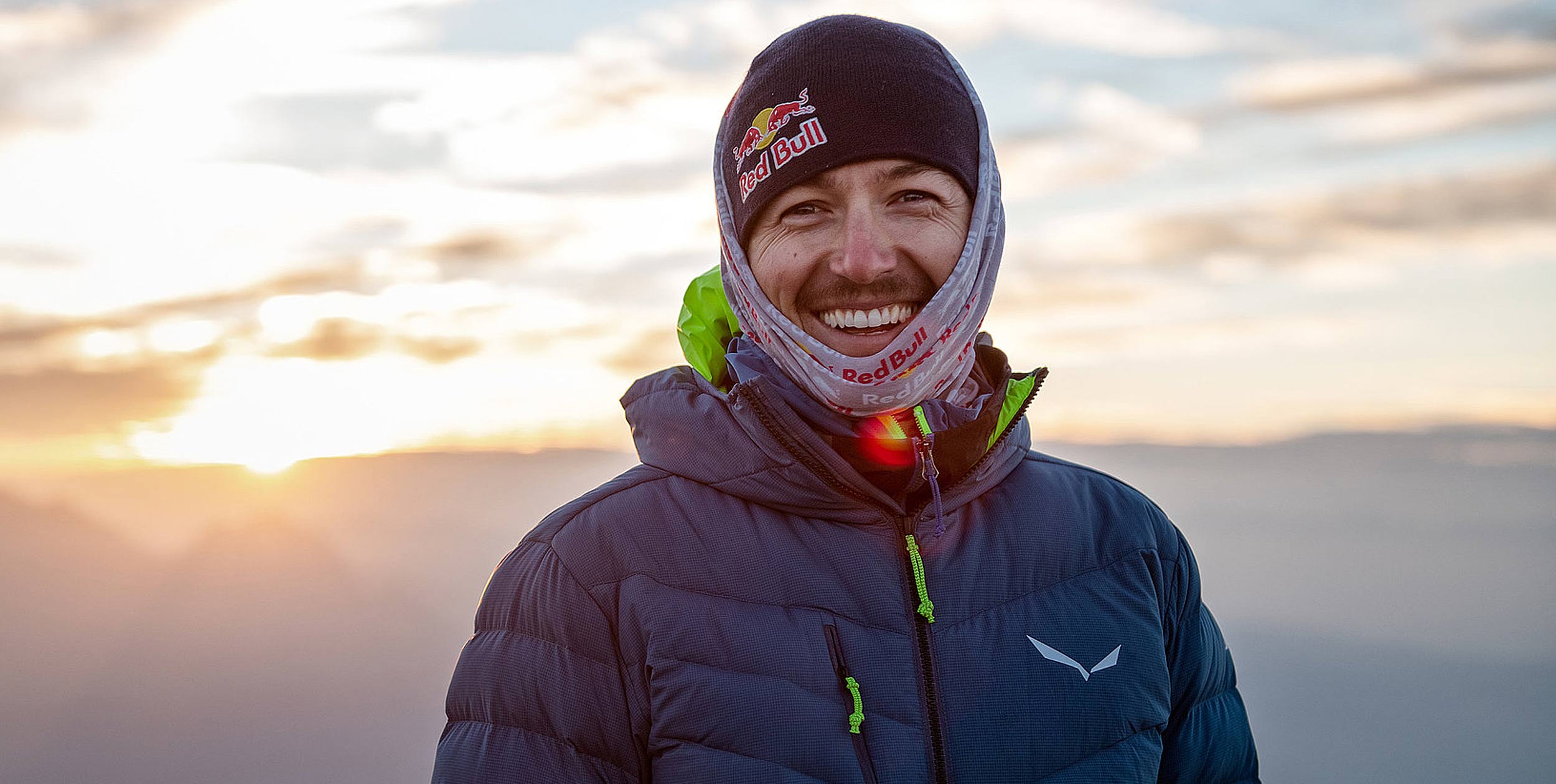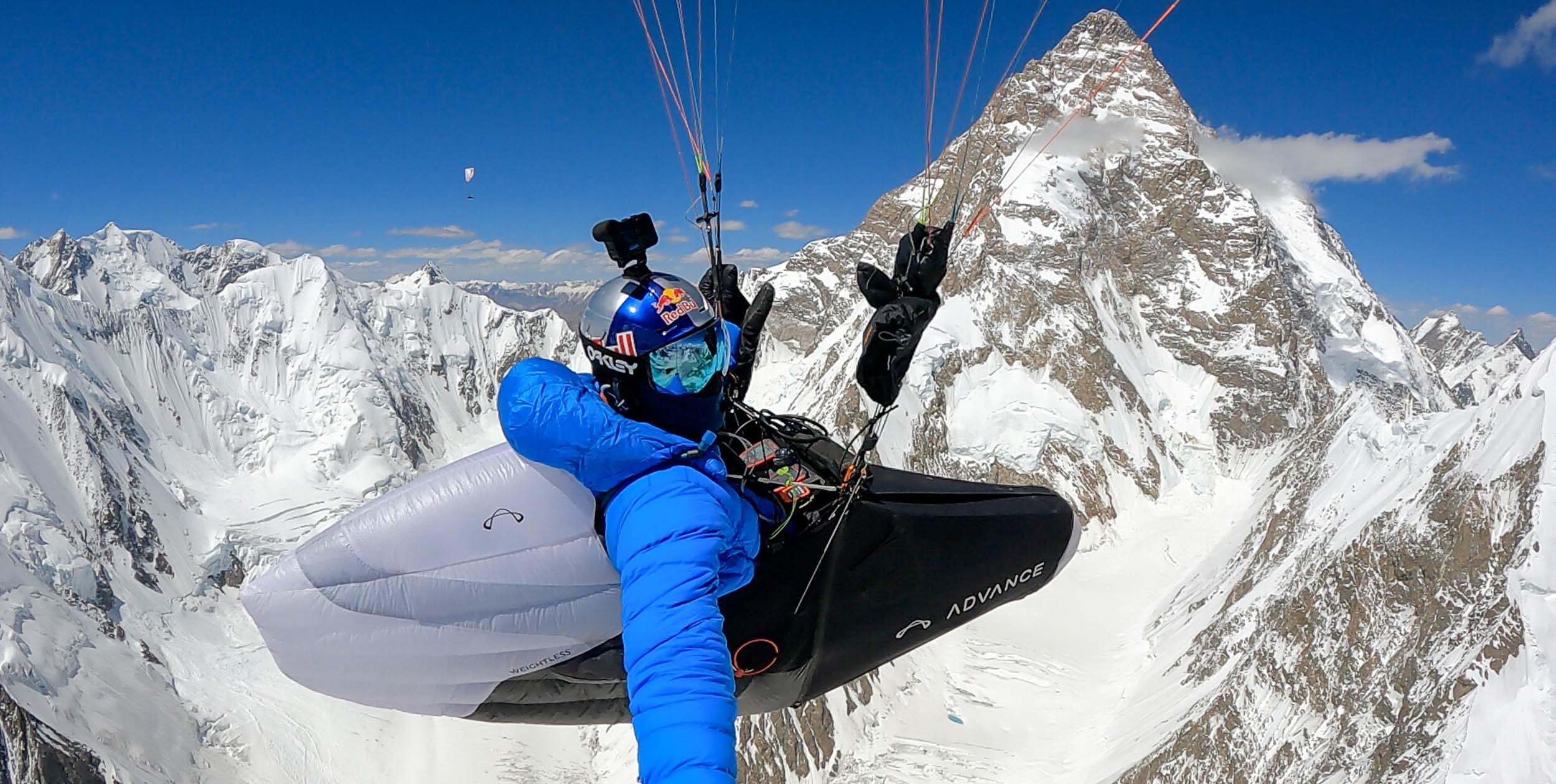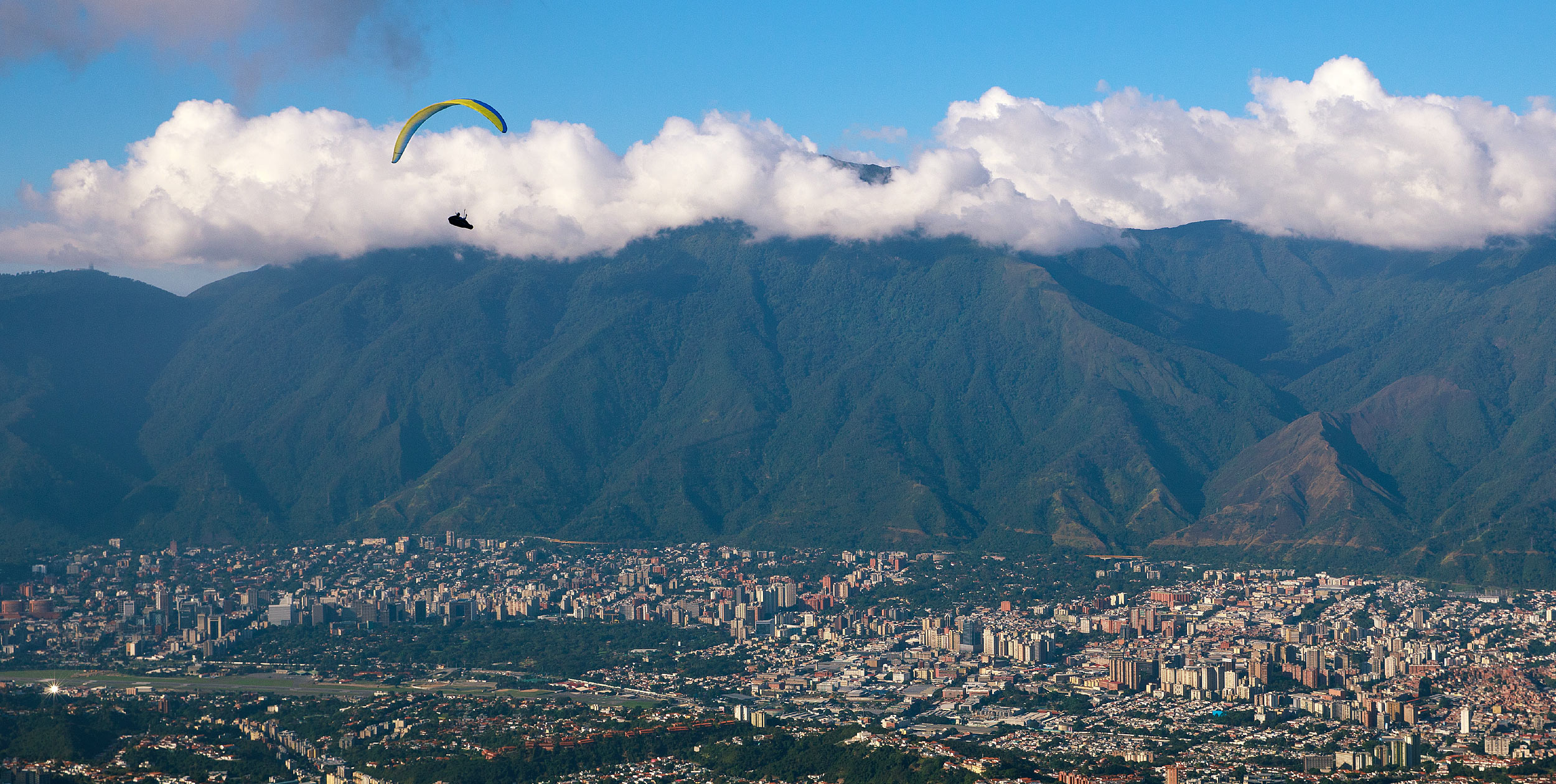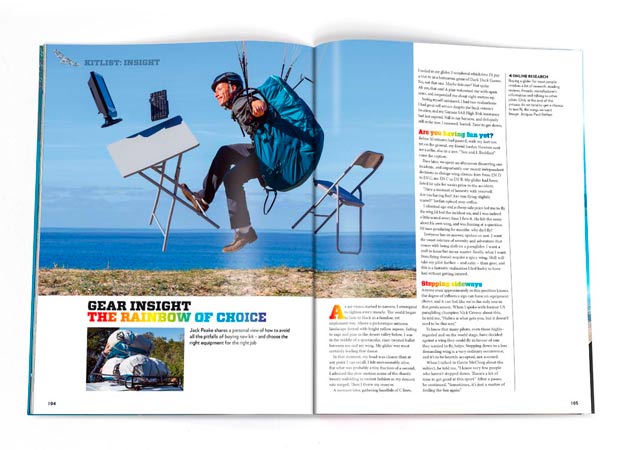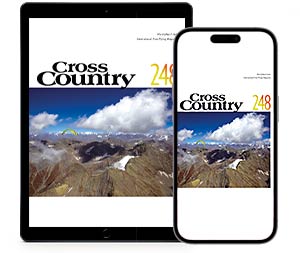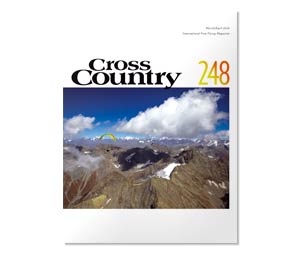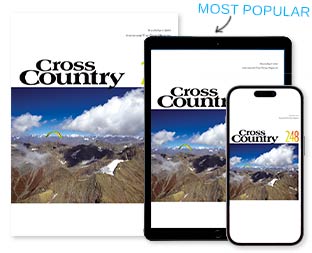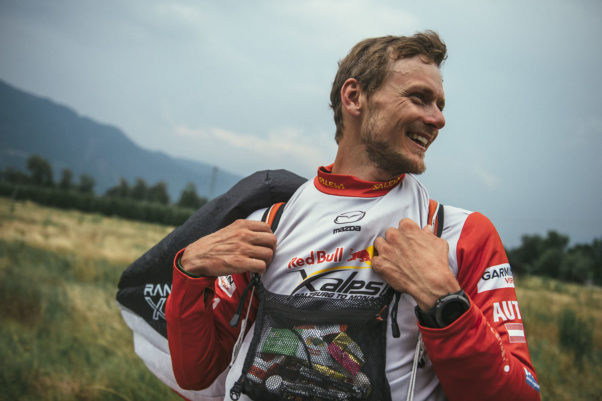
Paul Guschlbauer (AUT1) during the Red Bull X-Alps at Merano, Italy on 7 July 2015. Photo: Kelvin Trautman / Red Bull Content Pool
What’s it really like to take part in the Red Bull X-Alps? Cross Country Magazine writer Matt Warren spent four gruelling days chasing Paul Guschlbauer – and his dog, Vitali – around Austria’s mountains to find out
Paul Guschlbauer is finishing a can of Red Bull (yes, he really does drink it) and I’m pondering the wisdom of what I am about to do. “It’s a sheer face, but you can do it,” he says. “It’s easy really. Just think about being in the air.”
You know it’s going to be a tricky launch when you can’t identify the take-off – even when you’re standing in the middle of it. In this case, it’s a five-foot gap in the bushes … facing a vertiginous drop, in very light conditions and on a small mountain glider I’ve never flown before. If I’d been here on my own, I would have walked right by.
There’s space to lay out a glider behind the bushes, but there’s only room for a couple of strides before the precipice, and the ground on the northeast face is still caked in soggy, calf-deep snow. Best of all, David the photographer is standing by to capture the moment for posterity.
But then what did I expect? I have just climbed to the 1,648m summit of Schlenken with Paul – a Red Bull-sponsored athlete who is about to face his fourth Red Bull X-Alps – to get a sense of what it takes to compete in one of world’s most gruelling races. In the Red Bull X-Alps, you have to snatch every opportunity, however small. You can’t let the odd hairy take-off get in the way.
Keeping up
It’s not easy keeping up with Paul Guschlbauer. Now 33, he has twice stood on the X-Alps podium (he came third in both 2011 and 2015), is a keen bush pilot (he regularly flies his Piper Super Cub in Alaska) and has spent his entire life in the mountains. High peaks and remote places are his passion – and his profession.
“From the very beginning, I was outside,” he says. “I grew up in southern Austria, near Graz, and even when I was just a couple of weeks old, my father [Reinhard] used to carry me around for hours in the snow. I even got frostbite on my nose when I was a baby.”
His father – who sadly died suddenly of a heart attack earlier this year – also helped to nurture in Paul a ruthless competitive streak. When he was 13, and despite being small for his age, Paul told his father that he wanted to compete in the Dolomiti Superbike, a legendary mountain bike competition. The minimum age requirement was 16, so his father helped him to use a false name to get a place. Paul subsequently became Austria’s number one mountain biker.
“My father was a real inspiration,” he says. In fact, outside the X-Alps, Paul’s only real rival now is his three-year-old miniature Doberman, Vitali (named after the boxer, Vitali Klitschko).
“Recently, I went on a 45km run in the mountains,” he says. “It involved 4,000m vertical and took ten hours – and Vitali ran with me the whole way. He’s crazy.”
Back on Schlenken, the conditions change dramatically and strong, herb-scented thermals start barrelling up the other side of the mountain. We move to a far gentler slope on the mountain’s western flank but the first howling gust nearly hauls us both into the bushes. The next cycle is a little kinder, though, and we launch into booming mountain air, the chocolate box Austrian meadows below.
For the sake of my legs and lungs – this is hike and fly, after all – I’m using a Skywalk Masala 2 XXS. It’s small, swift, agile and a huge amount of fun, but by the time I take a thermal high above the mountain, Paul’s glider (a modified Skywalk Poison X-Alps XS) is a white speck against the broad blue sky … and he’s gone.
An hour or so later, I land out and go for a long lunch. And two hours after that, I receive a phonecall. It’s Paul. He tells me that he has completed a 60km triangle, landed at the bottom and walked back to the summit … again. He now intends to fly home. I drive his car – an ageing 300 horsepower Subaru Impreza – back to town.
The start
Paul started paragliding in 2006 after giving up mountain biking – “I suddenly had so much time. And after all that cycling, I thought paragliding looked like an easy way to explore the mountains.”
He had big ambitions from the outset, though. “When I first started training at a school, I told the instructor that I was learning paragliding to take part in the X-Alps,” he says.
“And so whenever the weather was even a little bit good, I went paragliding. I got my licence in the autumn, did my first thermal flight the following February, and two weeks later did a 50km cross country. So the next day, feeling like a real XC star, I went back to the same mountain. The conditions were different, though, and I got a huge collapse and landed in a tree. I think that tree saved my life. My glider caught the last branch and left me dangling half a metre from the ground. It was craziness.”
“I then went with a friend to Innsbruck. We hiked up a big mountain and took off on a very thermic day and I just didn’t know what I was doing. I stalled the glider and I had twists and was spiralling down. I didn’t pull my rescue, I just put my hands up and it all recovered, but I decided I had to do something so I bought two rescues and booked myself on an SIV. The SIV course changed everything. It transformed my flying.”
But while Paul’s flying started to improve dramatically, it was his love of the active life – and prodigious endurance – that set him apart from most pilots.
“I was always interested in cross country flying, but my style was different from everyone else’s. There was no light kit in those days – and I had an acro harness and my two rescues – but every day I’d fly out from the mountain. Some days, I’d fly XC, but if I didn’t I’d land at the bottom, walk up and try again. I’d just keep trying … and I didn’t mind all those hikes.”
Slowly, the X-Alps competitor was taking shape.
The Gaisberg
The next day, we head for the Gaisberg, the 1,288m summit on the edge of Salzburg that marks the start of the X-Alps. The trail winds its way up through thick forest, scented with the fragrance of wild garlic. He moves at a blistering pace, which seems to quicken with each stride and we’re up it in under an hour. He appears to have caught a whiff of the approaching X-Alps and just can’t seem to help himself. Despite this, he jokes the whole way up – and I try to laugh when I’m not panting too hard.
At the top, we bump into two-times PWC Superfinal winner Aaron Durogati, who is also competing in this year’s X-Alps. He is (good-humouredly) fuming after taking an involuntary sled ride to the bottom earlier in the day – yes, it can happen to anyone. The top of the Gaisberg has three official take-offs and we launch into light thermals, flying around the huge radio mast on the summit.
There’s no potential for XC flying, though, so Paul and Aaron peel off to race each other into the valley. On full bar, their gliders leave me – on an Ozone Swift 4 – standing. In July, they will spend hours like this, likely in the lee of vast mountains.
I land after them in a field by a small church and find them packing away their gliders. Aaron asks me if I’ve seen his glider strap, which clearly is already wrapped around the top of his wing. Apparently, it’s a bit of thing among top pilots. “We always seem to be looking for something,” laughs Paul. “I’m always searching my pockets to check I’ve got my keys, my wallet, my phone.”
“But I have had some coaching from Thomas Theurillat [Chrigel Maurer’s former supporter]. Before that, I was in a bit of a mess: I had no idea how to arrange things and I was always half an hour late for every meeting. He really helped with that. I now have crazy lists everywhere and I’m much more organised.”
Back in 2008, Paul’s flying took a detour.
“When the first speed riding wings came out, my friend Paul Kupsa and I decided we had to do it,” he says. “We rebuilt an old Volkswagen and travelled around making a movie [Speedraid], climbing crazy mountains and speed riding down. Now, everyone’s doing that kind of thing, but back then it was very unusual. It was something different.”
“But I was quite nervous of those small wings, and thought I’d prefer to fly competition gliders up high, where it was safer. My friend, on the other hand, wanted to go further and started wingsuit flying. Within a few years, he was killed. I’d never try wingsuit flying; I don’t need that adrenaline. I prefer to fly for eight hours in difficult conditions than have a two-minute near death experience.”
Around this time, Paul also started doing hike and fly races – and winning them. And in 2010, he won the Red Bull Dolomitenmann. “While I was there, I met Hannes Arch [who invented the Red Bull X-Alps and was race director of and pilot in the Red Bull Air Races] and told him that I wanted to take part in the X-Alps,” says Paul.
“So in 2011, I managed to get a place. After four or five years of paragliding, my dream had come true. If you have a goal in your head, it happens by itself. You end up doing the right things and meeting the right people. You have to try.”
Despite being a rookie, he also came third. “I really wasn’t experienced in 2011. I came third because I was strong, had good endurance and didn’t give up. I really wasn’t a very good pilot. I also made a strategy. I knew exactly how I wanted to walk it. The weather wasn’t that good in 2011, so that ended up being a real advantage.”
But no career is without its upsets. “2013 was my bad experience in X-Alps,” he says. “At the end of the second day, I was at the back of the field and I was so upset. My expectations were so high, but I just kept landing and it wasn’t at all as I wanted. Every day something was wrong.”
In the end, Paul clawed his way back into ninth position, but something was amiss. He felt he was lacking in motivation and decided that he needed a new goal.
“When I started paragliding, my original aim was to take part in the X-Alps, but after 2011, when I came third, that was done,” he says. “At the end of the 2013 race, I felt really down and in need of something else. So I spoke to Hannes Arch, who had always really supported me, and I asked whether there was a chance that I could become part of the Air Race – and he said, ‘Yes, you should just start flying airplanes.’ He made it sound that simple.”
And so he did. Paul now owns his own Piper Super Cub and has spent months in Alaska, mastering bush flying. He also still has an eye on powered aerobatics.
The X-Alps
On the afternoon after flying Gaisberg, we drive down to Red Bull’s Salzburg aerodrome. For aircraft aficionados, it is a pure pornography. There’s everything from World War Two bombers to stunt helicopters, all daubed in Red Bull regalia. Paul has access to a four-seater Cessna here, and we take it out for an early evening fly.
Flying past the Gaisberg, we can follow much of the straight line down to Triglav, in Slovenia, the first turnpoint in this year’s X-Alps – and the scale of the 1,138km race finally falls into stark relief. There aren’t many obvious valleys to follow; it’s a rocky maze and will likely involve some serious hiking, much of it over high passes. “Yep, it’s going to be very challenging this year,” says Paul. “And very, very physical.”
He can still remember the pain of 2015. He came third in that race and was out front with Chrigel Maurer at the Annecy turnpoint … until a catastrophic decision nearly sank his campaign completely. While Chrigel took a direct line south through the big mountains, Paul swung to the southwest towards Grenoble and took his chances at the very edge of the Alps, with the flatlands to his right.
“It could have paid off,” says Paul. “But this strong northerly picked up and I couldn’t fly. I could see Chrigel on the tracker flying to goal, and many of the other pilots catching up in the air – and I had to go by foot. We just didn’t see the wind on the forecast.”
Only a march of epic proportions – and a night pass – saved his race, but even then he faced near disaster when he got flushed down a mountainside and into a tree just short of goal. “It was so fortunate,” he says. “My supporters had taken a wrong turn in the van and drove past just as I was trying to get the glider out of the tree.”
Despite the setbacks, he’d earned his place on the podium once again.
Given the challenge ahead, Paul has a surprisingly relaxed approach to training – for him, being active and outdoors is a passion, not a necessity. It’s simply a way of life. There are no formal exercise routines pinned to his wall (yet) and, remarkably, he often forgets to eat. “I’m a bit thin at the moment,” he says. “I’ll go fully vegan for the race and my girlfriend, Lena [a massage therapist], will cook for me, but I’m not on any kind of special diet at the moment.”
“The X-Alps is my number one priority now, but for the last two years I have been trying to get away from just thinking about the race. There are so many other things to do. To only focus on the X-Alps, which is only every two years, means risking so much. I don’t mean risking death, but risking not living your life. You can focus fully on the X-Alps for two years and then injure yourself on the first day. You need other things in life.”
At home
Back at Paul’s fourth-floor apartment in Hallein, we sit in his office, surrounded by paragliders, helmets, climbing ropes, post-it notes … and plans. On a whiteboard on the wall, six months of 2018 is daubed with a single word: “Over:Land”.
“It’s my big project,” he says. “I want to fly my Super Cub from Alaska to Patagonia, having adventures and climbing big mountains along the spine of the Americas. I’ll start in midsummer in Alaska and finish six months later in midsummer in Patagonia. When I first had the idea, I asked [legendary Red Bull pilot] Andy Heidegger whether it would be possible. ‘Yes, of course you can do it,’ he said. ‘Just start.’ That was a huge motivation.”
“I love the planning, the business side of my adventures. I like to organise it all. To get up, and go training, and then have lunch before training some more would not be enough for me. I really like to think about things and make plans and run it like a business.
For this, he thanks Hannes Arch, who died last year in a tragic helicopter crash.
“Hannes was a real mentor for me and he has left me with some valuable lessons. He created a very successful job out of being an adventurer. That has rubbed off on me. I can invent projects and write descriptions for them and market them and raise funding for them. This is my job – and in my free time, which I like to have a lot of, I go paragliding. It’s a way of keeping his memory alive.”
Our final climb is up Bergköpfel (1,480m) with Lena and Vitali. There are no paragliders this time; it’s a Sunday “family day”.
“So, do you think you can win this year?” I ask at the top.
“Maybe,” he says. “If I do a lot of work. Chrigel’s still the best, but you never know what will happen in the X-Alps. And anyway, there are other adventures. Life’s about far more than just one thing.”
And with that, Paul, Lena, Vitali and I start running down the mountain.
This article appeared in Cross Country 180 (June 2017)


